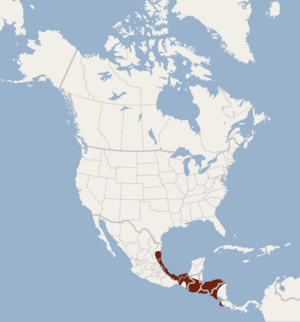Black-winged little yellow bat facts for kids
Quick facts for kids Black-winged little yellow bat |
|
|---|---|
 |
|
| Conservation status | |
| Scientific classification | |
| Genus: |
Rhogeessa
|
| Species: |
tumida
|
 |
|
| Synonyms | |
|
Rhogeessa parvula tumida |
|
The black-winged little yellow bat (scientific name: Rhogeessa tumida) is a small bat that lives in Central America. It belongs to a group of bats called vesper bats.
What Does It Look Like?
The black-winged little yellow bat is quite small. It grows to be about 6 to 8 centimeters long. That's roughly the length of a credit card! Both male and female bats are about the same size.
Their fur is usually a yellowish or light brown color. It can have hints of dark brown or cinnamon. The fur on their belly is often lighter than on their back.
These bats have wings that are hairless. Their wing membranes are also thicker than what you might expect for such a small bat. Their ears are smaller compared to other bats in their family.
Male bats have a special scent gland on top of their ears. This gland helps them communicate, but females do not have it.
Bat Habits and Life
Scientists don't know a lot about the daily lives of these bats. They are often found near streams or rivers. These bats like to sleep in hollow trees or in buildings made by people.
They are nocturnal, meaning they are active at night. They are busiest right after the sun sets and just before it rises. Black-winged little yellow bats eat small, flying insects.
These bats have different numbers of chromosomes. Chromosomes are tiny structures inside cells that carry genetic information. Some have 30, 32, 34, or even 52 chromosomes.
Mating usually happens in the autumn and early winter. Female bats have been found pregnant between February and April. Sometimes, this bat species has been known to mix with the Yucatan yellow bat. This means they can have babies together.
Where Do These Bats Live?
Black-winged little yellow bats live along the eastern coast of Mexico. You can find them as far north as southern Tamaulipas. They also live along the Pacific coast in Chiapas.
They are common across most of Honduras, Guatemala, and Belize. You can also find them in northern and western Nicaragua. They live in north-western Costa Rica too.
These bats only live in areas below about 1,500 meters (about 4,900 feet) in elevation. They can live in almost any type of natural area. However, they seem to prefer forests where trees lose their leaves in certain seasons.


